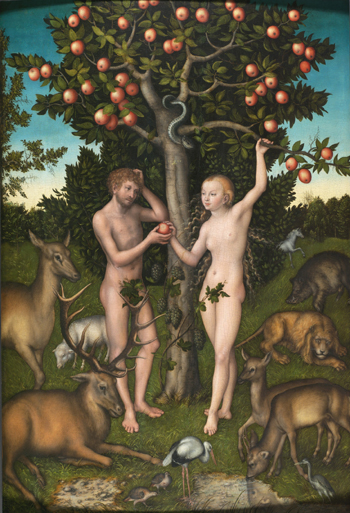Lucas Cranach’s Eve is a lithe Germanic temptress with an alluring half smile playing on her lips. Her skin is pale, her frame slender. She might almost be an ivory figurine come to life. With her left hand she reaches up to caress one of the boughs of the Tree of Knowledge. As if in response to some charge of unseen electricity generated by that contact, the long curls of her white-blonde hair flare and crackle, creating a radiant nimbus of spiralling tresses around her naked form. She is the original pin-up, imagined at the moment when she plunges mankind into Original Sin.
Poor bamboozled Adam, delivered into temptation by this irresistible sex queen, stands no chance. A seemingly simple fellow, he scratches his head with his left hand while with his right he takes the fateful apple offered to him by his consort. He looks like a man in a trance, destined to succumb but caught in the last instant of his indecision. Above the couple, twined in the branches of the tree, the serpent stretches down towards Eve. Its whispering has to be imagined – the false promise that forbidden fruit will transform man and woman into gods.
This nakedly titillating image of sexual temptation is liberally sown with Christian symbolism. That was in part how Cranach allowed his patrons, pillars of the Saxon nobility, to enjoy his soft pornography with a clear conscience – his way of arming them with the alibi of pious reflection. A grape vine springs from the Tree of Knowledge, its leaves decorously covering Adam and Eve’s genitalia, its bunches of fruit symbolising the wine of the Eucharist – and thus the salvation of mankind from sin by Christ, “the second Adam”. A menagerie of emblematic beasts has congregated at the couple’s feet,...


